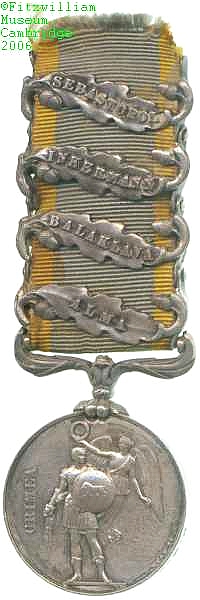
Obverse, a bust of Queen Victoria

Reverse, a Roman warrior being wreathed by the flying figure of Victory

Obverse, a bust of Queen Victoria |

Reverse, a Roman warrior being wreathed by the flying figure of Victory |
Rivalry between Britain and Russia over India, and between Russia and France over the protection of Christians under Ottoman rule, led in the 1850s to a focus of diplomatic attention on the ailing Ottoman Empire. British diplomatic successes led to a Russian attempt to annexe the Danubian principalities of Moldavia and Wallachia from the Ottomans, as well as the Russian destruction of the Ottoman Black Sea fleet when Turkey went to war in retaliation. Britain and France moved in support of the Ottomans and although the Danubian provinces were returned the allies' conditions for peace far exceeded this. The Russian refusal to meet these conditions led to full-scale international war in late 1854.
The war was mainly composed of allied attempts to reduce Russian fortresses on the Black Sea (and also on the Baltic), of which only the lengthy siege of Sevastopol was successful, but Russian attrition there and elsewhere was so heavy and the Russian ability to force withdrawal on the allies so inadequate, despite opening a second front, that Tsar Nicholas I made peace in 1856.
An early allied success was the defeat at Alma in 1854 of a larger Russian army that had been sent to oppose the initial allied landings. Other less successful engagements between the same armies arose at Inkermann in November 1854, and shortly before at the Battle of Balaklava, in which a Russian attempt to lift the siege of Sevastopol failed but inflicted heavy British casualties, including most famously upon the Light Brigade in their legendary suicide charge.
This medal bears bars for participation in all these battles, and also for action during the long siege of Sevastopol. It was awarded to Private H. McMonagh, of the 1st Battalion of the 1st Rifle Brigade. Lester Watson acquired it at some point before 1928.